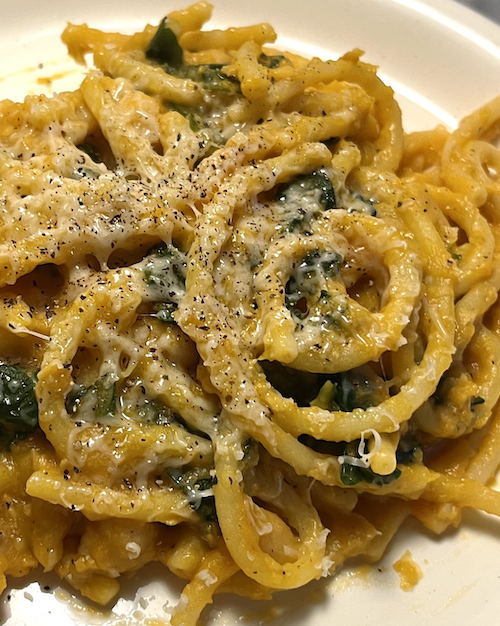
c/o Gemmarosa Ryan
For this semester’s final issue of The Argus, I wanted to share a classic Tuscan recipe passed down to me from my mother. Pasta e Ceci—pasta with chickpeas—is an emblematic dish of the Tuscan “cucina povera” (peasant cooking). While unassuming and cheap to make, this dish manages to turn the most simple of ingredients into a meal that will impress your dinner party guests and cure your Sunday scaries. It never fails to warm my heart and fill my stomach—I can only hope it does the same for you. Since the last issue is a special occasion, I invited my wonderful fellow Food Section editors Lia Franklin ’24 and Lewis Woloch ’24 over to my humble Low Rise so that we could all enjoy the pasta—and there wasn’t a singular bucatino left in the pot when we finished eating. It was the first of many dinners that we will have together.
If you want to keep up with what I’ll be cooking over the summer, follow me on Instagram @wannabechefg, and stay tuned for the launching of my substack.
Grazie mille for reading the column, and until next year,
Chef G
Ingredients:
Serves 2-3
1 can chickpeas
300 grams of pasta (Bucatini, Ditalini, Tagliatelle)
1 medium carrot
1 medium stalk celery
1/2 white onion
3 tablespoons tomato paste
2 cups vegetable or chicken broth
1/2 bunch Tuscan kale
4 tablespoons olive oil
1 sprig rosemary
2 cloves of garlic
Salt and pepper
Instructions
- In a food processor or by hand, finely chop the carrots, celery, and onions. Mince garlic separately.
- Remove the vegetable mixture and blend half a can of chickpeas, putting aside the other half of whole chickpeas to use later.
- Heat up four tablespoons of olive oil in a Dutch oven or large saucepan over medium heat. Add in the carrot, celery, and onion mix. Season with a pinch of salt and pepper.
- Sweat the vegetables out until fragrant and translucent, around four minutes.
- Add in garlic and rosemary, cooking for another two minutes.
- Add in the tomato paste, cooking until it turns brick red, around two minutes.
- Add in the two cups of broth to de-glaze the pan, making sure to scrape up any bits stuck to the bottom of the pot.
- Add in the chickpea purée and the remaining whole chickpeas, along with a heavy pinch of salt and pepper, and bring the mixture to a soft boil.
- Once boiling, add in the pasta and lower to a simmer. Cook until the pasta is perfectly al dente, adding more broth/water if there isn’t enough liquid or if the mixture looks dry.
- Add in the kale, stirring into the pasta and letting it wilt.
- Serve with a fresh grating of Parmesan, a scrunch of black pepper, a sprinkle of salt, and another drizzle of olive oil.
Gemma Ryan can be reached at gryan@wesleyan.edu.
Comments are closed